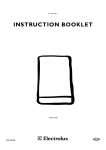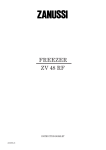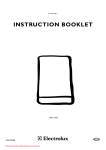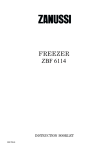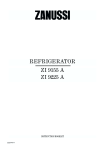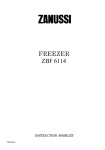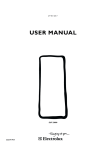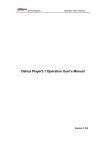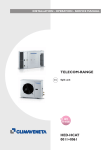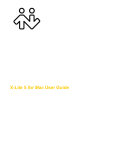Download Electrolux EUF14800 Operating instructions
Transcript
Cupright freeze OPERATING INSTRUCTIONS EUF14800 2222782-01 Packing disposal Important safety instructions 2 Maintenance Instructions for the User Use Cleaning the interior Control panel Display Operation Temperature regulation Mode Selection How to power off the appliance Freezing of fresh foods High-Temperature alarm Door Ajar alarm Storage of commercially frozen food Ice packs Freezing calendar Thawing Ice-cube production Tips Tips for freezing fresh food Tips for storage of commercially frozen food 3 Defrosting Periodic cleaning Periods of non-operation 10 10 10 Guarantee Condition 13 Something not working 5 Service and Spare Parts 5 Customer care department 5 5 5 6 6 6 6 6 7 7 7 8 8 8 8 9 10 11 12 12 Standard guarantee conditions Exclusion European Guarantee 13 13 13 Installation 15 Technical specifications Positioning Door reversal Electrical connection Building-in 14 15 15 16 17 9 9 9 PACKING DISPOSAL Except for wood material, the packing and packaging materials used for our major appliances can and should be recycled. In countries where suitable recycling programs have been set up, you may return the packing to the store you purchased your appliance from. Customers are encouraged to: • Bring paper, cardboard and corrugated board packing to the suitable collection bins.. • Bring plastic packing parts to the suitable collection bins. Please dispose of these materials with your household garbage only if no solid waste recycling program is available in your area. In line with our packaging policy, we only use recyclable packaging materials, such as: PLASTIC PARTS Key to symbols PE stands for polyethylene ** 02 =^ HDPE; 04 =^ LDPE PP stands for polypropylene PS stands for polystyrene Most of the plastic materials used in your appliance are marked with suitable codes to facilitate sorting for disposal and/or recycling. 2 IMPORTANT SAFETY INSTRUCTIONS It is most important that this instruction book should be retained with the appliance for future reference. Should the appliance be sold or transferred to another owner, or should you move house and leave the appliance, always ensure that the book is supplied with the appliance in order that the new owner can be acquainted with the functioning of the appliance and the relevant warnings. These warnings are provided in the interest of safety. You must read them carefully before installing or using the appliance. General Safety • This appliance is designed to be operated by adults. Children should not be allowed to tamper with the controls or play with the product. • Before any cleaning or maintenance work is carried out - such as replacing the interior light bulb, where fitted - be sure to switch off and unplug the appliance. • Ice lollies can cause frost burns if consumed straight from the appliance. • This appliance is heavy. Care should be taken when moving it. • Take utmost care when handling your appliance so as not to cause any damages to the cooling unit with consequent possible fluid leakages. • The appliance must not be located close to radiators or gas cookers. • Avoid prolonged exposure of the appliance to direct sunlight. • There must be adequate ventilation round the back of the appliance. Avoid any damage to the refrigerant circuit. • FOR FREEZERS ONLY (except built-in models): an ideal location is the cellar or basement. • Do not use other electrical appliances (such as ice cream makers) inside refrigerating appliances. Service / Repair • Any electrical work required to install this appliance should be carried out by a qualified electrician or competent person. • This appliance should be serviced by an authorised Service Centre. • Use genuine spare parts only. • This appliance contains hydrocarbons in its cooling unit; maintenance and recharging must therefore only be carried out by authorised technicians. • Never use metal objects for cleaning your appliance as it may get damaged. • Under no circumstances should you attempt to repair the appliance yourself. Repairs carried out by inexperienced persons may cause injury or more serious malfunctioning. Refer to your local Service Centre, and always insist on genuine spare parts. Positioning • Care must be taken to ensure that the appliance does not stand on the electrical supply cable. Important: If the supply cable is damaged, it must be replaced with a special cable of the same type or a special kit available from the manufacturer or from authorised service centres. • During normal operation, the condenser and compressor at the back of the appliance heat up considerably. For safety reasons, minimum ventilation must be as shown in the relevant paragraph. Attention: Keep ventilation openings clear of obstruction. • Parts which heat up (such as compressor housing, condenser and their piping) should not be exposed. Wherever possible the back of the product should be against a wall. • If the appliance has been transported horizontally, it is possible that the oil contained in the compressor flows in the refrigerant circuit. It is advisable to wait at least two hours before connecting the appliance to allow the oil to flow back in the compressor. Use • The domestic refrigerators and freezers are designed to be used specifically for the storage of edible foodstuffs only. • Frozen food must not be re-frozen once it has been thawed out. • Manufacturers’ storage recommendations should be strictly adhered to. Refer to relevant instructions. • Typically, the cooling parts of all refrigerators and freezers will develop frost and/or ice build-up over time. On Manual Defrost models, frost must be removed manually, whereas No-Frost models will defrost automatically. Never use metal objects for defrosting your appliance as it may get damaged. Frost may be removed by using the supplied plastic scraper. • Do not use any mechanical device or artificial means to speed up the thawing process other than those recommended by the manufacturer. • Do not use sharp or pointed instruments to scrape off frost or ice. • Never put fizzy drinks in the freezer as they might well burst. 3 Environment Protection • This appliance does not contain gasses which could damage the ozone layer, in either its refrigerant circuit or insulation materials. The appliance shall not be discarded together with household garbage or solid urban waste. Avoid damaging the cooling unit, especially at the rear near the heat exchanger. Information on collection schedules or local disposal sites may be obtained from your municipal authorities. • The materials used on this appliance marked with the symbol are recyclable. Disposal of old appliances The symbol on the product or on its packaging indicates that this product may not be treated as household waste. Instead it shall be handed over to the applicable collection point for the recycling of electrical and electronic equipment. By ensuring this product is disposed of correctly, you will help prevent potential negative consequences for the environment and human health, which could otherwise be caused by inappropriate disposal of this product. For more detailed information about recycling of this product, please contact your local city office, your household waste disposal service or the shop where you purchased the product. 4 USE This appliance is marked with the symbol food and for long-term storage of frozen food. , which means that the compartment is suitable for freezing fresh Cleaning the interior Before using the appliance for the first time, wash the interior and all internal accessories with lukewarm water and some neutral soap so as to remove the typical smell of a brand-new product, then dry thoroughly. Do not use detergents or abrasive powders, as these will damage the finish. Control panel A - Power ON/OFF switch B - Display with temperature readout and mode indicator C - Mode selection / alarm reset button D - Freezer temperature control DISPLAY 1. Door Ajar alarm indicator 2. Temperature plus/minus sign 3. Temperature readout 4. "Fast-Freee On" indicator (turns on when fast-freeze 5 Operation If the display does not light up after the plug is plugged into the wall socket, press switch (A) to power on the appliance As soon as the appliance is powered on, the control panel display should show the following:. • Plus sign (2) indicates that temperature is positive. • Temperature readout blinking, red display background and buzzer beeping. Press button (C) to stop the buzzer (see also paragraph “High- Temperature Alarm”): Turn the freezer knobs to mid position to obtain the following temperature: approx. -18°C inside freezer This freezer compartment is marked with the symbol, which means that the compartment is suitable for freezing fresh food and for longterm storage of frozen food. Temperature regulation Temperature inside this compartment may be set in a -15°C to -24°C range by turning knob (D). Temperature inside the freezer is adjusted automatically. Temperature setting may be increased (warmer) by turning the thermostat towards symbol (• ) or reduced (colder) by the turning the knob to- wards symbol ( ). • However, the exact setting should be chosen keeping in mind that the temperature inside the appliance depends on: • room temperature; How to power off the appliance To power off the appliance , hold the “A” switch depressed for over 1 sec. The temperature readout changes to a count down. The display will count down from 3 to 1 and then turn off. Freezing of fresh foods The freezer compartment is suitable for freezing fresh food and for storing frozen or deep-frozen food. The maximum amount of food which is freezable in 24 hours is indicated on the rating plate. To freeze food, place the recommended quantity of food (see „rating plate“) in direct contact with the inner liner (remove drawer or basket). If food is put to freeze in the drawers or baskets, maximum freezable quantity will be smaller. Food to be frozen must be placed in the top (i.e. the coldest) compartment. To freeze fresh food, use the Fast Freeze mode. Press button C (repeatedly, if needed) until the Fast Freeze mode symbol/indicator appears. The appliance should run on the quick-freeze setting for at least 24 hours before the foods are put in the freezer. Once the foods have been placed in the freezer, the freezing operation can be considered to be complete 24 hours later. During the freezing process, do not add any more foods for freezing. This mode will switch off automatically after 54 hours. Arrange the food to be frozen as shown in the figure. • how often the door is opened; • the quantity of food stored; • location of appliance. Therefore, we suggest you turn the knob to a medium setting. To freeze fresh food and safely store frozen or deepfrozen food, the inner temperature of the freezer must be at least -18° C or colder. Mode selection At each press of button C, the following modes are activated (in clockwise order): Symbol 4: Fast Freeze mode No symbol: normal operation 6 Any one mode can be switched off at any time by pressing button C (see paragraph „Mode selection“). High-Temperature Alarm If temperature inside the freezer compartment rises too high (for instance, in the event of a power failure), it will trigger the following indications: - temperature readout blinks; - symbol 3 blinks; - display turns red; - buzzer beeps. When temperature is back to normal: - the buzzer stops beeping; - the temperature readout keeps blinking; - the display stays red. When you press the Alarm Reset button C, readout 4 shows the actual peak temperature reached inside the compartment for 5 seconds, and then the display will stop blinking and return to its normal colour. During an alarm, you may turn off the buzzer by pressing button C; the display will stay red until normal operating conditions are restored. Door Ajar alarm The Door Ajar alarm will activate if the door is left ajar for about 1 minute. A Door Ajar alarm condition is indicated by: - symbol (1) blinking; - the display turning red; - the buzzer beeping. Press button (C) to stop the buzzer. When normal operating conditions are restored (closed door): - the buzzer stops beeping. Storage of frozen food When you first start the freezer or if the freezer has been out of use for some time, wait at least 12 hours before storing frozen food in your appliance. If you need to store large quantities of food and wish to use the full capacity of your appliance, you may remove all drawers and baskets (except the bottom drawer) and place the food directly on the (cold) shelves. Products must only be stacked up to the maximum capacity mark (where present) on the cabinet wall. Important Food thawed accidentally (for instance, during a power outage) should be used within a short time or cooked and refrozen immediately (after cooling to room temperature) if the appliance has been out of operation longer than the safe "Storage time in the event of a failure" indicated in the technical data chart. 7 Ice packs The appliance comes with two ice packs. In the event of a power cut or appliance failure, the ice packs will help preserve frozen food for several more hours than the normally allowed storage period when the freezer is out of operation. This will work best is the ice packs are placed up front in the top drawer. You may also use the supplied ice packs in your portable cooler. Freezing Calendar The symbols show different types of frozen goods. The numbers indicate storage times in months for the appropriate types of frozen goods. Whether the upper or lower value of the indicated storage time is valid depends on the quality of the foods and pre-treating before freezing. 8 Thawing Deep-frozen or frozen food, prior to being used, can be thawed in the refrigerator or at room temperature, depending on the time available for this operation. Small pieces may even be cooked still frozen, directly from the freezer. In this case, cooking will take longer. Ice-cube production This appliance is equipped with one or more trays for the production of ice-cubes. Fill these trays with water, then put them in the freezer. Do not use metallic instruments to remove the trays from the freezer. TIPS Tips for freezing fresh foods To help you get the best out of the freezing process, here are a few hints: • Freeze only good-quality, fresh and well-cleaned foods. Split them into small portions to speed up freezing and avoid having to thaw more food than you require. It is in fact important to remember that once the foods have thawed out, they deteriorate fast and must not be refrozen. • Another point to remember is that lean foods keep better and longer than fatty foods. Salt too reduces storage times; • Wrap the foods in foil or polythene film, ensuring that the wrapping adheres closely to the food and is well sealed. In this way, by avoiding contact with air, the colour, flavour and nutritional value of the foods remain intact. • You should never freeze all at once a greater quantity of foods than the maximum indicated on the appliance’s rating plate; • During the freezing process, do not add further foods for freezing and do not open the freezer door; • The foods for freezing should not be placed in contact with already frozen foods, but put in the special freezing compartment. This will stop the temperature of already frozen foods from rising; Tips for storage of commercially frozen food To get the best out of your freezer, here are a few hints: You should ensure that: • the deep-frozen foods have been correctly stored by the retailer; • the products are brought home and placed in the freezer as soon as possible after purchase; • products are not stored for longer than the time specified by the food manufacturer; • Avoid opening the door too frequently and when you do open it, leave it open only for as long as is strictly necessary; • A word of warning about ice lollies: they should not be eaten straight out of the freezer as this might cause cold burns; • If there is a power failure when food is in the freezer, do not open the door of the freezer. The frozen food will not be affected if the power cut is of short duration and the freezer is full. Otherwise, it is recommended that the food be used within a short time. • Never put fizzy drinks in the freezer as they might well burst; • In addition, never put hot foods or liquids in the freezer compartment and take care not to fill recipients up to the brim if they are covered with a lid. 9 MAINTENANCE Unplug the appliance before carrying out any maintenance operation. Warning This appliance contains hydrocarbons in its cooling unit. Maintenance and recharging must therefore only be carried out by authorised technicians. Defrosting The freezer evaporator will defrost whenever the compressor in not in operation. Defrost water flows through a drain channel into a drain pan located over the compressor at the rear of the appliance and evaporates. Freezer compartment The freezer compartment defrosts automatically. Periodic cleaning Never use metal objects for cleaning your appliance as it may get damaged. Clean the inside with lukewarm water and a mild detergent. Rinse and dry thoroughly. To guarantee a safe operation of the fridge, once a year remove the ventilation grille at the base and clean the air channels with a vacuum cleaner. This helps ensure proper operation, resulting in energy saving. 10 Periods of non-operation When the appliance is not in use for long periods, take the following precautions: remove the plug from the wall socket; remove all food; defrost and clean the interior and all accessories; leave the door ajar to allow air to circulate to prevent unpleasant smells. SOMETHING NOT WORKING If the appliance is not functioning properly, check that: Malfunction Freezer temperature is too warm Compressor runs all the time Excess ice and frost build-up Cooling system does not work Compressor makes repeated start attempts and fails to come on The appliance works, the green light is flashing Remedy - Is temperature setting to low? - Has warm food been stored in the appliance recently? - Has a large amount of food been stored in the appliance recently? - Did you arrange the goods properly so as to allow sufficient cooling air circulation? - Is the door closed correctly? - Was the door left open too long or opened too often? - Is the temperature control set too high? - Is sufficient air circulation provided at the rear of theappliance? - Are the slots of the kickplate grille unobstructed? - Is the food stored in the appliance properly wrapped? - Was the door left open? - Was the door opened too frequently or left open too long? - Is the gasket in good condition? - Is something inside the freezer keeping the door slightly open? - Check to see if the temperature setting is between "1" and "6". - Power off the appliance, wait 20 minutes and power it back on again. Please contact the nearest service centre. If your appliance is still not working properly after making the above checks, contact the nearest service centre. To obtain fast service, it is essential that when you apply for it you specify the model and serial number of your appliance which can be found on the guarantee certificate or on the rating plate located inside the appliance, on the bottom left-hand side. 11 SERVICE AND SPARE PARTS In the event of your appliance requiring service, or if you wish to purchase spare parts, please contact your local Electrolux Service Force Centre by telephoning: 0870 5 929929 Your telephone call will be automatically routed to the Service Force Centre covering your post code area. For the address of your local Service Force Centre and further information about Service Force, please visit the website at www.serviceforce.co.uk Before calling out an engineer, please ensure you have read the details under the heading ‘Something Not Working? When you contact the Service Force Centre you will need to give the following details: 1. Your name, address and post code 2. Your telephone number 3. Clear and concise details of the fault 4. The model and serial number of the appliance (found on the rating plate) 5. The purchase date Please note that a valid purchase receipt or guarantee documentation is required for in-guarantee service calls. CUSTOMER CARE DEPARTMENT For general enquiries concerning your Electrolux appliance or for further information on Electrolux products, please contact our Customer Care Department by letter or telephone at the address below or visit our website at www.electrolux.co.uk Customer Care Department Electrolux Major Appliances Addington Way Luton Bedfordshire LU4 9QQ 08705 950 950 * * calls to this number may be recorded for training purposes. 12 GUARANTEE CONDITIONS Standard guarantee conditions We, Electrolux, undertake that if within 12 months of the date of the purchase this Electrolux appliance or any part thereof is proved to be defective by reason only of faulty workmanship or materials, we will, at our option repair or replace the same FREE OF CHARGE for labour, materials or carriage on condition that: The appliance has been correctly installed and used only on the electricity supply stated on the rating plate. The appliance has been used for normal domestic purposes only, and in accordance with the manufacturer’s instructions. The appliance has not been serviced, maintained, repaired, taken apart or tampered with by any person not authorised by us. All service work under this guarantee must be undertaken by an Electrolux Service Force Centre. Any appliance or defective part replaced shall become the Company’s property. This guarantee is in addition to your statutory and other legal rights. Home visits are made between 8.30am and 5.30pm Monday to Friday. Visits may be available outside these hours in which case a premium will be charged. Exclusions This guarantee does not cover: Damage or calls resulting from transportation, improper use or neglect, the replacement of any light bulbs or removable parts of glass or plastic. Costs incurred for calls to put right an appliance which is improperly installed or calls to appliances outside the European Community (EC) or European Free Trade Area. Appliances found to be in use within a commercial environment, plus those which are subject to rental agreements. Products of Electrolux manufacture which are not marketed by Electrolux. European Guarantee If you should move to another country within Europe then your guarantee moves with you to your new home subject to the following qualifications: The guarantee starts from the date you first purchased your product. The guarantee is for the same period and to the same extent for labour and parts as exists in the new country of use for this brand or range of products. This guarantee relates to you and cannot be transferred to another user. Your new home is within the European Community (EC) or European Free Trade Area. The product is installed and used in accordance with our instructions and is only used domestically, i.e. a normal household. The product is installed taking into account regulations in your new country. Before you move please contact your nearest Customer Care centre, listed below, to give them details of your new home. They will then ensure that the local Service Organisation is aware of your move and able to look after you and your appliances. France Senlis +33 (0)3 44 62 20 13 Germany Nürnberg +49 (0)800 234 7378 Italy Pordenone +39 (0)800117511 Sweden Stockholm +46 (0)20 78 77 50 UK Luton +44 (0)8705 950 950 13 TECHNICAL SPECIFICATIONS POWER SUPPLY VOLTAGE AND FREQUENCY TOTAL POWER ABSORBED AVERAGE DAILY UNITS ELECTRICITY (*) GROSS CAPACITY NET CAPACITY . 230-240 V/ 50 HZ 1A 0,64 KWH 135 L 135 L (*) THIS FIGURE IS BASED ON STANDARD TEST RESULTS IN ACCORDANCE WITH EUROPEAN STANDARD EN153. ACTUAL CONSUMPTION WILL DEPEND ON HOW THE APPLIANCE IS USED AND WHERE IT IS LOCATED. 14 INSTALLATION Warning IF YOU ARE DISCARDING AN OLD APPLIANCE THAT HAS A LOCK OR CATCH ON THE DOOR, YOU MUST ENSURE THAT IT IS MADE UNUSABLE TO PREVENT YOUNG CHILDREN BEING TRAPPED INSIDE. Door reversal The appliance’s door has been locked in position for transport by means of pins on both sides. According to the door opening direction, remove relevant pins at the top and at the bottom. Depending upon the position which you choose for your appliance, you may wish to reverse the way in which the door opens. To do this, refer to instructions under “Door reversal”. Positioning The appliance should only be installed at a location where the ambient temperature corresponds to the climate classification indicated on the rating plate, which is located on the inside left of the appliance. The following table shows which ambient temperature is correct for each climate classification. SN +10¡C to +32¡C ST +18¡C to +38¡C The appliance should be located in a dry atmosphere, out of direct sunlight and away from continuous heat and extreme temperature, e.g. not next to a boiler or radiator or in a very cold room e.g. an outhouse. If these temperatures are exceeded i.e. warmer or colder, then the appliance may not operate correctly. For building-in and door reversal instructions please refer to the relevant instructions on the following pages. Attention! After completion of the door reversing operation, check that the door gasket adheres to the cabinet. If the ambient temperature is cold (i.e. in Winter), the gasket may not fit perfectly to the cabinet. In that case, wait for the natural fitting of the gasket or accelerate this process by heating up the part involved with a normal hairdryer on a low setting. 15 Electrical Connection WARNING THIS APPLIANCE MUST BE EARTHED. The manufacturer declines any liability should this safety measure not be observed. If the plug that is fitted to your appliance is not suitable for your socket outlet, it must be cut off and the appropriate plug fitted. Remove the fuse from the cut off plug. The cut off plug should then be disposed of to prevent the hazard of shocks in case it should be plugged into a 13amp socket in another part of your home. Important The wires in the mains lead are coloured in accordance with the following code: Green and Yellow - Earth Blue - Neutral Brown - Live If you fit your own plug, the colours of the wires in the mains lead of your appliance, may not correspond with the markings identifying the terminals in your plug, proceed as follows: Connect the Green and the Yellow (earth) wire to the terminal in the plug which is marked with the letter “E” or the earth symbol , or coloured green and yellow. Connect the blue (neutral) wire to the terminal in the plug which is marked with the letter “N” or coloured black. Connect the brown (live) wire to the terminal in the plug which is marked with the letter “L” or coloured red. The plug moulded onto the lead incorporates a fuse. For replacement, use a 13amp BS1362 fuse. Only ASTA or BSI approved fuses should be used. The plug must not be used if the fuse cover/carrier is lost. The cover/carrier is indicated by the coloured insert at the base of the plug. This appliance complies with the following E.E.C. Directive: -73/23 EEC of 19.2.73 (Low Voltage Directive) and subsequent amendments. - 87/308 of 2.6.87 (Radio Interference Suppression) and subsequent amendments. - 89/336 EEC of 3.5.89 (Electromagnetic Compatibility Directive) and subsequent amendments. Please ensure that when the appliance is installed it is easily accessible for the engineer in the event of breakdown. 16 BUILDING-IN Dimensions of the recess Height of housing (1) mm Depth of housing (2) mm Width of housing (3) mm EUF 14800 1225 550 560 1. Fit the appliance in the niche by making sure that it stands against the interior surface of the unit on the side where the door hinges of the appliances are fitted. Insert the appliance until the upper stripbutts up against the unit (1) and make sure that the lower hinge is in line with the surface of the unit (2). It is necessary that the cabinet has a ventilation recess with the following dimensions: Depth 50 mm Width 540 mm For appropriate venting, follow indications in the figure. 2. Press in the joint covers between the appliance and the kitchen furniture. 3. Open the door and push the appliance against the side of kitchen furniture opposite to that of the appliance hinges. Fasten the appliance with 4 screws (I) provided in the kit included with the appliance. 17 4. Snap vent grill (B) and hinge cover (E) into position. Apply blanking covers (C-D) as indicated. 5. Separate parts Ha, Hb, Hc, Hd as shown in the figure. 8. Open the appliance door and the furniture door at 90¡. Insert the small square (Hb) into guide (Ha). Put together the appliance door and the furniture door and mark the holes as indicated in the figure. 9. Remove the squares and mark a distance of 8 mm from the outer edge of the door where the nail must be fitted (K). 6. Place guide (Ha) on the inside part of the furniture door, up and down as shown in the figure and mark the position of external holes. After having drilled holes, fix the guide with the screws supplied. 10. Place the small square on the guide again and fix it with the screws supplied. Should the alignment of the furniture door be necessary, use the clearance of slots. At the end of this procedure, it is necessary to check if the door of the furniture closes properly. 7. Fix cover (Hc) on guide (Ha) until it clips into place. 11. Fix cover (Hd) on the small square (Hb) until it clips into place. 18




















